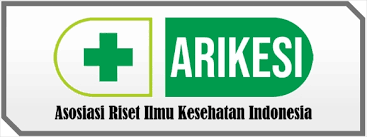Association Between Curve Magnitude in Scoliosis and Low Body Mass Index
Abstract
Background: Adolescent idiopathic scoliosis is a spinal deformity characterized by Cobb angle deviation of more than 10o. Objective: This study aims to determine the association between low body mass index (BMI) and curve magnitude in adolescent idiopathic scoliosis. Methods: This was a retrospective cohort study using medical record data of patients diagnosed with scoliosis at Bhayangkara Tk I Pusdokkes Polri Hospital. BMI classification was based on WHO BMI-for-ages z-scores in children and adolescents. Result: The study included 22 AIS subjects, with the majority aged 14–17 years and a higher proportion of females than males. The p-value for the association between low body mass index and adolescent idiopathic scoliosis is 0.169. Conclusion: Curve magnitude is not associated with low body mass index.
Keywords
Full Text:
PDFReferences
Achsar, A. M., & Fatoni, A. Z. (2021). Manajemen Pasien Dekstroskoliosis Berat dengan Kegagalan Napas yang disebabkan oleh Syok Septik dan Pneumonia. Journal of Anaesthesia and Pain, 2(1), 40–47. https://doi.org/10.21776/ub.jap.2021.002.01.05
Burwell, R. G., Clark, E. M., Dangerfield, P. H., & Moulton, A. (2016). Adolescent idiopathic scoliosis ( AIS ): a multifactorial cascade concept for pathogenesis and embryonic origin. Scoliosis, 1–7. https://doi.org/10.1186/s13013-016-0063-1
Ceballos-Laita, L., Carrasco-Uribarren, A., Cabanillas-Barea, S., Pérez-Guillén, S., Pardospardos-Aguilella, P., & Del Barrio, S. J. (2023). The effectiveness of Schroth method in Cobb angle, quality of life and trunk rotation angle in adolescent idiopathic scoliosis: a systematic review and meta-analysis. European Journal of Physical and Rehabilitation Medicine, 59(2), 228–236. https://doi.org/10.23736/S1973-9087.23.07654-2
Chung, S. (2015). Body mass index and body composition scaling to height in children and adolescent. Annals of Pediatric Endocrinology & Metabolism, 20(3), 125. https://doi.org/10.6065/apem.2015.20.3.125
Dimeglio, A., & Canavese, F. (2020). The immature spine: growth and idiopathic scoliosis. Annals of Translational Medicine, 8(2), 22–22. https://doi.org/10.21037/atm.2019.11.134
Erkkila, I. P., Reynolds, C. A., Weissman, J. P., Levine, O. P., & Aronson, H. (2023). Factors Associated with Presentation of Severe Adolescent Idiopathic Scoliosis. Journal of the Pediatric Society of North America, 5(3), 651. https://doi.org/10.55275/JPOSNA-2023-651
Fabijan, A., Zawadzka-fabijan, A., Fabijan, R., Zakrzewski, K., Nowosławska, E., & Polis, B. (2024). Assessing the Accuracy of Artificial Intelligence Models in Scoliosis Classification and Suggested Therapeutic Approaches.
Horng, M. H., Kuok, C. P., Fu, M. J., Lin, C. J., & Sun, Y. N. (2019). Cobb angle measurement of spine from x-ray images using convolutional neural network. Computational and Mathematical Methods in Medicine, 2019. https://doi.org/10.1155/2019/6357171
Jeon, K. K., & Kim, D. Il. (2021). Low body mass index levels and idiopathic scoliosis in korean children: A cross-sectional study. Children, 8(7). https://doi.org/10.3390/children8070570
Kim, S., Uhm, J. Y., Chae, D. H., & Park, Y. (2020). Low Body Mass Index for Early Screening of Adolescent Idiopathic Scoliosis: A Comparison Based on Standardized Body Mass Index Classifications. Asian Nursing Research, 14(1), 24–29. https://doi.org/10.1016/j.anr.2019.12.003
Komang-Agung, I. S., Dwi-Purnomo, S. B., & Susilowati, A. (2017). Prevalence rate of adolescent idiopathic scoliosis: Results of school-based screening in surabaya, Indonesia. Malaysian Orthopaedic Journal, 11(3), 17–22. https://doi.org/10.5704/MOJ.1711.011
Lee, G. Bin, Priefer, D. T., & Priefer, R. (2022). Scoliosis: Causes and Treatments. Adolescents, 2(2), 220–234. https://doi.org/10.3390/adolescents2020018
Li, C., Zhang, B., Liu, L., Li, Y., Xu, Y., Wang, L., Yun, C., & Zhao, Y. (2021). Design, reliability, and validity of a portable electronic device based on ergonomics for early screening of adolescent scoliosis. Journal of Orthopaedic Translation, 28(June 2020), 83–89. https://doi.org/10.1016/j.jot.2020.10.014
Matusik, E., Durmala, J., Olszanecka-Glinianowicz, M., Chudek, J., & Matusik, P. (2020). Association between bone turnover markers, leptin, and nutritional status in girls with adolescent idiopathic scoliosis (AIS). Nutrients, 12(9), 1–13. https://doi.org/10.3390/nu12092657
Miyagi, M., Saito, W., Imura, T., Nakazawa, T., Shirasawa, E., Kawakubo, A., Uchida, K., Akazawa, T., Inage, K., Ohtori, S., Inoue, G., & Takaso, M. (2021). Body composition in Japanese girls with adolescent idiopathic scoliosis. Spine Surgery and Related Research, 5(5), 68–74. https://doi.org/10.22603/SSRR.2020-0088
Mudhari, D. N. R., Rahmawati, N. A., & Jumianti, S. E. (2024). Penyuluhan Fisioterapi Mengenai Postur Tubuh sebagai Pencegahan Skoliosis pada Remaja di Madrasah Aliyah Al – Irtiqo ’ Kota Malang. Jurnal Abdi Masyarakat Indonesia, 4(6), 1511–1517.
https://doi.org/https://doi.org/10.54082/jamsi.1320
Nuryani, R., Ayuningsih, A., Wulan Lindasari, S., Dolifah, D., & Sopiah, P. (2024). Dampak Skoliosis terhadap Psikologis Remaja. JurnalKeperawatan, 16(1). https://doi.org/https://doi.org/10.32583/keperawatan.v16i1.1416
Palhinha, L., Liechocki, S., Hottz, E. D., Pereira, J. A. da S., de Almeida, C. J., Moraes-Vieira, P. M. M., Bozza, P. T., & Maya-Monteiro, C. M. (2019). Leptin Induces Proadipogenic and Proinflammatory Signaling in Adipocytes. Frontiers in Endocrinology, 10(December). https://doi.org/10.3389/fendo.2019.00841
Parmitha, I. A. J. A., Kinandana, G. P., Andayani, N. L. N., & Fridayani, N. K. Y. (2023). Correlation between body mass index with scoliosis: a narrative review. Physical Therapy Journal of Indonesia, 4(2), 255–259. https://doi.org/10.51559/ptji.v4i2.64
Peng, Y., Wang, S. R., Qiu, G. X., Zhang, J. G., Zhuang, Q. Y., & Wang, N. N. (2020). Research progress on the etiology and pathogenesis of adolescent idiopathic scoliosis. Chinese Medical Journal, 133(4), 483–493. https://doi.org/10.1097/CM9.0000000000000652
Petrosyan, E., Fares, J., Ahuja, C. S., Lesniak, M. S., Koski, T. R., Dahdaleh, N. S., & El Tecle, N. E. (2024). Genetics and Pathogenesis of Scoliosis. North American Spine Society Journal (NASSJ), 20(September), 100556. https://doi.org/10.1016/j.xnsj.2024.100556
Scaturro, D., Balbo, A., Vitagliani, F., Stramazzo, L., Camarda, L., & Letizia Mauro, G. (2022). Is There a Relationship between Idiopathic Scoliosis and Body Mass? A Scoping Review. Nutrients, 14(19), 1–13. https://doi.org/10.3390/nu14194011
Sun, D., Ding, Z., Hai, Y., & Cheng, Y. (2023). Advances in epigenetic research of adolescent idiopathic scoliosis and congenital scoliosis. In Frontiers in Genetics (Vol. 14). Frontiers Media SA. https://doi.org/10.3389/fgene.2023.1211376
Supartono, B., Gamma, R., Wiyono, S., & Yuli, S. (2016). P-3 The influence of scoliosis towards secondary osteoarthritis of the knee joint in athletes. A33.1-A33. https://doi.org/10.1136/bjsports-2016-097120.56
Utami, F., & Adyas, A. (2022). Analysis of Practical Methods of Early Detection of Scoliosis. Journal of Prosthetics Orthotics and Science Technology, 1(2), 81–92. https://doi.org/10.36082/jpost.v1i2.830
Wang, Q., Wang, C., Hu, W., Hu, F., Liu, W., & Zhang, X. (2020). Disordered leptin and ghrelin bioactivity in adolescent idiopathic scoliosis ( AIS ): a systematic review and meta-analysis. Journal of Orthopaedic Surgery and Research, 1–9. https://doi.org/https://doi.org/10.1186/s13018-020-01988-w
Woods, N., Wittmeier, K., Mulder, K., Dufault, B., & Black, B. (2022). The Relationship Between Body Mass Index and the Magnitude of Curve at Diagnosis of Adolescent Idiopathic Scoliosis: A Retrospective Chart Review. Orthopedic Research and Reviews, 14(May), 149–155. https://doi.org/10.2147/ORR.S359394
Zadjali, F., Al Farsi, B., Zadjali, R., Bayoumi, R. A., Al Barwani, S., & Al-Yahyaee, S. (2023). Gender-specific Reference Range for Serum Leptin in Omani Population. Oman Medical Journal, 38(5), 84–90. https://doi.org/10.5001/omj.2023.96
Zheng, S., Zhou, H., Gao, B., Li, Y., Liao, Z., Zhou, T., Lian, C., Wu, Z., Su, D., Wang, T., Su, P., & Xu, C. (2018). Estrogen promotes the onset and development of idiopathic scoliosis via disproportionate endochondral ossification of the anterior and posterior column in a bipedal rat model. Experimental and Molecular Medicine, 50(11). https://doi.org/10.1038/s12276-018-0161-7
DOI: http://dx.doi.org/10.30742/jikw.v14i1.4219
Refbacks
- There are currently no refbacks.
Copyright (c) 2025 Alya Roza Lisanti

This work is licensed under a Creative Commons Attribution-NonCommercial 4.0 International License.
Jurnal Ilmiah Kedokteran Wijaya Kusuma is licensed under a Creative Commons Attribution-NonCommercial 4.0 International License










